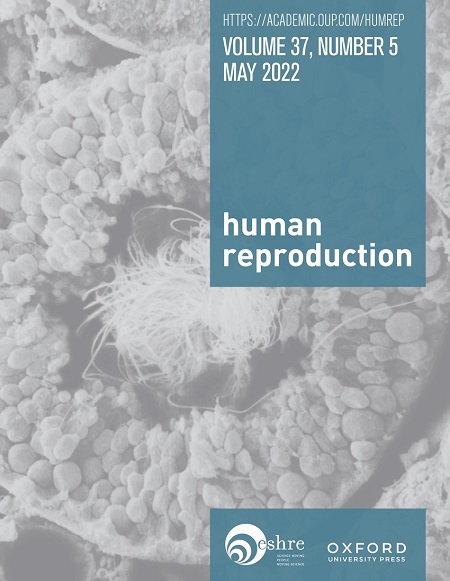First-trimester maternal folate and vitamin B12 concentrations and their associations with first-trimester placental growth: the Rotterdam Periconception Cohort.
IF 6
1区 医学
Q1 OBSTETRICS & GYNECOLOGY
引用次数: 0
Abstract
STUDY QUESTION Are maternal folate and vitamin B12 concentrations associated with first-trimester placental growth? SUMMARY ANSWER Maternal folate concentrations and commencement of folic acid supplements prior to conception, as compared to following conception, are positively associated with first-trimester placental volume (PV), whereas no associations were found for maternal vitamin B12 concentrations. WHAT IS KNOWN ALREADY Besides the protective effect of folic acid supplement use against neural tube defects and other adverse birth outcomes, the preconceptional commencement of folic acid supplements is positively associated with postpartum placental size, although conflicting outcomes have been reported. Studies in mice show an association with vitamin B12 deficiency and decreased placental weight postpartum. STUDY DESIGN, SIZE, DURATION Between January 2010 and December 2020, 480 pregnancies (727 longitudinal ultrasound measurements) with known maternal folate and/or vitamin B12 blood concentrations in the first trimester and 875 pregnancies (1430 longitudinal ultrasound measurements) with known timing of folic acid supplement initiation were included in the Rotterdam Periconception Cohort, a prospective, hospital-based observational cohort. PARTICIPANTS/MATERIALS, SETTING, METHODS Red blood cell (RBC) folate and serum vitamin B12 concentrations were determined in first-trimester maternal blood, and the timing of folic acid supplement use was collected using validated questionnaires. PV was measured from serial 3-dimensional ultrasounds performed at 7, 9, and 11 weeks of gestation. Linear mixed models were used to assess the associations between maternal folate and vitamin B12 concentrations with first-trimester PVs. Analyses were adjusted for gestational age at ultrasound, maternal age, BMI, geographical background, education level, parity, smoking, mode of conception, and the other B vitamins. For validation, the association between the timing of folic acid supplement initiation (pre- or postconception) and PV was assessed. MAIN RESULTS AND THE ROLE OF CHANCE The median RBC folate concentration was 1395 nmol/l (IQR 1169-1588) and the median serum vitamin B12 concentration was 314 pmol/l (IQR 241-391). For RBC folate, the smallest PVs were found in women in the lowest quartile, with the largest difference as compared to women in the fourth quartile: 3√PV (β = -0.141, 95% CI = -0.249 to -0.033, P = 0.010), corresponding to a 1.79 cm3 (-18.7%) and a 6.99 cm3 (-9.9%) smaller PV at 7 and 11 weeks of gestation, respectively. Additionally, PV was significantly smaller in women who initiated folic acid supplements following rather than prior to conception: 3√PV (β=-0.129, 95% CI = -0.207 to -0.051, P = 0.001) corresponding to a 1.69 cm3 (-16.9%) and a 6.62 cm3 (-8.9%) smaller PV at 7 and 11 weeks of gestation, respectively. We found no significant association between maternal serum vitamin B12 concentrations and PV. LIMITATIONS, REASONS FOR CAUTION The observational design of this study does not exclude residual confounding, and our hospital-based study population, with mostly adequate RBC folate and serum vitamin B12 concentrations, could limit the generalizability of our results. WIDER IMPLICATIONS OF THE FINDINGS Our results emphasize the importance of the preconceptional commencement of folic acid supplements to achieve adequate maternal RBC folate concentrations, which could support optimal placental growth during the first trimester and also protect against neural tube defects and other adverse birth outcomes. STUDY FUNDING/COMPETING INTEREST(S) This study was funded by the Department of Obstetrics and Gynecology and the Department of Developmental Biology of the Erasmus MC, University Medical Center, Rotterdam, the Netherlands. K.D.S. was in receipt of funding from the Biotechnology and Biological Sciences Research Council (BBSRC) (BB/K017810/1). The authors declare that they have no conflict of interests. TRIAL REGISTRATION NUMBER NTR4356.妊娠早期母体叶酸和维生素B12浓度及其与妊娠早期胎盘生长的关系:鹿特丹围孕期队列
研究问题:母体叶酸和维生素B12浓度与妊娠早期胎盘生长有关吗?与怀孕后相比,怀孕前母体叶酸浓度和叶酸补充剂的开始与妊娠早期胎盘体积(PV)呈正相关,而母体维生素B12浓度与胎盘体积(PV)没有关联。除了叶酸补充剂对神经管缺陷和其他不良出生结果的保护作用外,孕前开始服用叶酸补充剂与产后胎盘大小正相关,尽管有相互矛盾的结果报道。对小鼠的研究表明,维生素B12缺乏与产后胎盘重量减少有关。研究设计、规模、持续时间在2010年1月至2020年12月期间,鹿特丹围孕期队列研究纳入了480例妊娠(727次纵向超声测量),妊娠早期母亲叶酸和/或维生素B12血药浓度已知,以及875例妊娠(1430次纵向超声测量)已知叶酸开始补充的时间。参与者/材料,环境,方法测定孕早期母亲血液中的红细胞叶酸和血清维生素B12浓度,并通过有效问卷收集叶酸补充剂的使用时间。PV在妊娠7、9和11周时通过连续三维超声测量。使用线性混合模型来评估母体叶酸和维生素B12浓度与妊娠早期pv之间的关系。对超声胎龄、产妇年龄、BMI、地理背景、教育程度、胎次、吸烟、受孕方式和其他B族维生素进行了调整。为了验证,叶酸补充剂开始的时间(孕前或孕后)和PV之间的关系进行了评估。红细胞叶酸浓度中位数为1395 nmol/l (IQR 1169-1588),血清维生素B12浓度中位数为314 pmol/l (IQR 241-391)。对于红细胞叶酸,最低四分位数的妇女的PV最小,与第四四分位数的妇女相比差异最大:3√PV (β = -0.141, 95% CI = -0.249至-0.033,P = 0.010),对应于妊娠7周和11周的PV分别减少1.79 cm3(-18.7%)和6.99 cm3(-9.9%)。此外,在怀孕后而不是怀孕前开始补充叶酸的妇女的PV明显更小:3√PV (β=-0.129, 95% CI = -0.207至-0.051,P = 0.001),对应于妊娠7周和11周的PV分别减少1.69 cm3(-16.9%)和6.62 cm3(-8.9%)。我们没有发现母体血清维生素B12浓度和PV之间的显著关联。本研究的观察性设计并没有排除残留的混杂因素,而且我们以医院为基础的研究人群,大部分红细胞叶酸和血清维生素B12浓度充足,可能限制了我们研究结果的普遍性。研究结果强调了孕前开始补充叶酸以获得足够的母体红细胞叶酸浓度的重要性,这可以在妊娠早期支持最佳胎盘生长,也可以防止神经管缺陷和其他不良出生结果。研究经费/竞争利益(S)本研究由荷兰鹿特丹大学医学中心Erasmus MC的妇产科和发育生物学部门资助。K.D.S.获得了生物技术和生物科学研究理事会(BBSRC)的资助(BB/K017810/1)。作者声明他们没有利益冲突。试验注册号为4356。
本文章由计算机程序翻译,如有差异,请以英文原文为准。
求助全文
约1分钟内获得全文
求助全文
来源期刊

Human reproduction
医学-妇产科学
CiteScore
10.90
自引率
6.60%
发文量
1369
审稿时长
1 months
期刊介绍:
Human Reproduction features full-length, peer-reviewed papers reporting original research, concise clinical case reports, as well as opinions and debates on topical issues.
Papers published cover the clinical science and medical aspects of reproductive physiology, pathology and endocrinology; including andrology, gonad function, gametogenesis, fertilization, embryo development, implantation, early pregnancy, genetics, genetic diagnosis, oncology, infectious disease, surgery, contraception, infertility treatment, psychology, ethics and social issues.
 求助内容:
求助内容: 应助结果提醒方式:
应助结果提醒方式:


